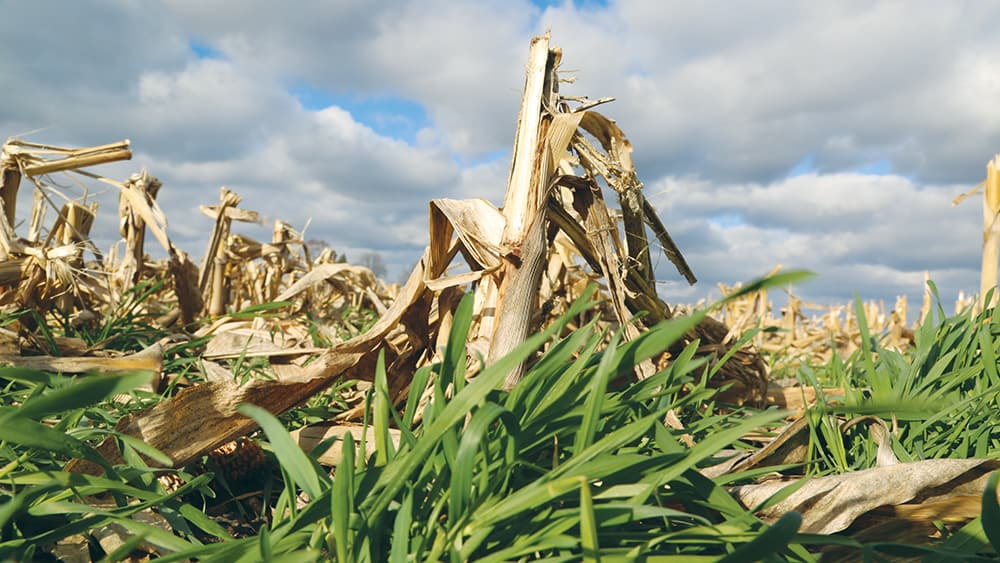
Steve Berger, a demonstration farm participant in the Soil Health Partnership, started to no-till in 1978. He has experimented with cover crops since 2000 and has planted all of his farm to cereal rye for the past 10 years.
Berger knows that adding cover crops to your farm’s system isn’t simple. The Wellman, Iowa, farmer admits to making mistakes, like the year he tried a southern cereal rye variety that he expected to increase dry matter by 40%. After an open winter, it did. The rye grew to seven feet before he could drill soybeans.
“It actually got away from me. I didn’t intend for that to happen,” he recalls. He flattened the rye with a roller crimper borrowed from a neighbor, using herbicide for good measure. Despite this challenge, he managed to raise acceptable 65-bushel soybeans.
So, if you’re about to roll into rye with a planter or drill this spring, he has a few suggestions:
Try beans first. If it fits into your crop rotation, he suggests starting with soybeans, not corn. Corn needs extra nitrogen early to offset nitrogen tied up by soil microbes breaking down the rye. Soybeans won’t. And soybean yields are more forgiving of any germination problems you might have.
While soils and the growing season vary across Iowa, Berger offers the following suggestions when planting corn or drilling soybeans into rye.
Terminate rye early. For first timers, he recommends spraying cereal rye when it has about three or four inches of growth (no more than six inches) or two weeks ahead of corn planting, whichever comes first.
Having used cover crops for more than a decade, Berger has altered his nitrogen program enough that he can terminate cover crops a week ahead of corn planting.
Adapt your planter. Berger drills soybeans in 10-inch rows, but you could use a splitter bar to switch from 30-inch rows for corn to 15-inch soybean rows in a no-till system.
Modifying your corn planter for no-tilling into rye residue doesn’t have to cost a fortune.
“Add something to your planter one thing at a time as you can afford it,” he says.
-
Consider using row cleaners to manage residue. “If I had one thing to do with the planter, I’d add row cleaners,” he says. “That’s a type of strip tillage ahead of the planter.” You don’t need an expensive high-end row cleaner, either, he says. Simple spiked wheels will do. The Iowa Soybean Association also advises wheels with broader, shorter teeth than older ones with long, slender teeth. Row cleaners should barely touch the soil, turning at maybe 75% to 80% of the planter speed through the field. They don’t need to turn continuously and should not move all of the rye residue out of the row. Berger doesn’t use coulters ahead of the row units.
-
Keep disc openers sharp and at factory recommended specs. Replace them when they have about a half-inch of wear. “We want to make sure those coulters are touching,” he says. “Definitely look at your operator’s manual. It will vary by the planter.”
-
Use a seed firmer to improve seed-to-soil contact and for more uniform emergence. This inexpensive plastic device pushes corn seed to the bottom of the V-trench, or furrow. It needs about a pound of pressure, which you can measure with a fish scale. Firmers cost a little more than $30 each and may need to be replaced each season due to wear.
-
Add spiked closing wheels and a drag chain. “We pull off the factory press wheel and put on a spiked closing wheel,” he says. “That will collapse your sidewall and make sure you don’t get any sidewall compaction.”
He further advises, “Take the spring tension off and just let the weight of the wheel do the down pressure.” Having the right downforce pressure on each unit is key. A drag chain behind the closing wheels ensures closure of the seed trench.
“It will pull some soil over it if there’s any open gaps,” he says. - Adjust planting depth. Plant deep enough to get even emergence.
